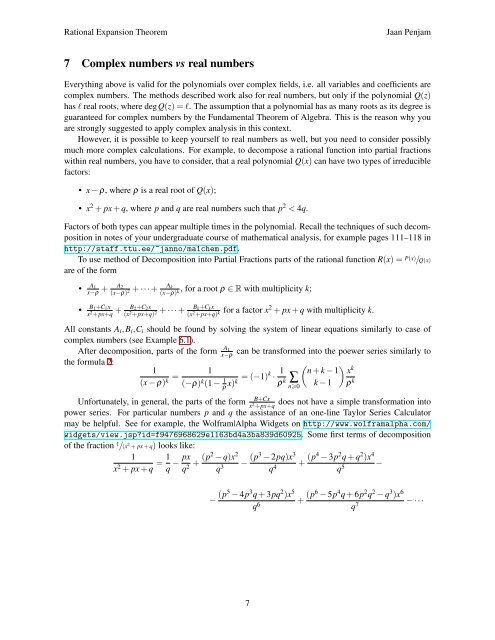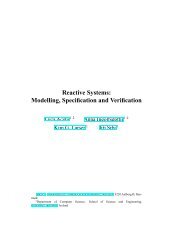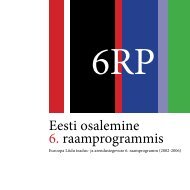Rational functions - Cs.ioc.ee
Rational functions - Cs.ioc.ee
Rational functions - Cs.ioc.ee
You also want an ePaper? Increase the reach of your titles
YUMPU automatically turns print PDFs into web optimized ePapers that Google loves.
<strong>Rational</strong> Expansion Theorem Jaan Penjam<br />
7 Complex numbers vs real numbers<br />
Everything above is valid for the polynomials over complex fields, i.e. all variables and coefficients are<br />
complex numbers. The methods described work also for real numbers, but only if the polynomial Q(z)<br />
has ℓ real roots, where degQ(z) = ℓ. The assumption that a polynomial has as many roots as its degr<strong>ee</strong> is<br />
guarant<strong>ee</strong>d for complex numbers by the Fundamental Theorem of Algebra. This is the reason why you<br />
are strongly suggested to apply complex analysis in this context.<br />
However, it is possible to k<strong>ee</strong>p yourself to real numbers as well, but you n<strong>ee</strong>d to consider possibly<br />
much more complex calculations. For example, to decompose a rational function into partial fractions<br />
within real numbers, you have to consider, that a real polynomial Q(x) can have two types of irreducible<br />
factors:<br />
• x − ρ, where ρ is a real root of Q(x);<br />
• x 2 + px + q, where p and q are real numbers such that p 2 < 4q.<br />
Factors of both types can appear multiple times in the polynomial. Recall the techniques of such decomposition<br />
in notes of your undergraduate course of mathematical analysis, for example pages 111–118 in<br />
http://staff.ttu.<strong>ee</strong>/~janno/ma1chem.pdf.<br />
To use method of Decomposition into Partial Fractions parts of the rational function R(x) = P(x)/Q(x)<br />
are of the form<br />
•<br />
A1 A2<br />
x−ρ + (x−ρ) 2 + ··· + Ak<br />
(x−ρ) k , for a root ρ ∈ R with multiplicity k;<br />
• B1+C1x<br />
x2 B2+C2x<br />
+ +px+q (x2 +px+q) 2 + ··· + Bk+Ckx<br />
(x2 +px+q) k for a factor x2 + px + q with multiplicity k.<br />
All constants Ai,Bi,Ci should be found by solving the system of linear equations similarly to case of<br />
complex numbers (s<strong>ee</strong> Example 6.1).<br />
After decomposition, parts of the form A1<br />
x−ρ can be transformed into the poewer series similarly to<br />
the formula 2:<br />
<br />
1<br />
n + k − 1 xk =<br />
(x − ρ) k k − 1 ρk 1<br />
(−ρ) k (1 − 1<br />
ρ x)k = (−1)k · 1<br />
ρ k ∑ n0<br />
Unfortunately, in general, the parts of the form B+Cx<br />
x 2 +px+q<br />
does not have a simple transformation into<br />
power series. For particular numbers p and q the assistance of an one-line Taylor Series Calculator<br />
may be helpful. S<strong>ee</strong> for example, the Wolfram|Alpha Widgets on http://www.wolframalpha.com/<br />
widgets/view.jsp?id=f9476968629e1163bd4a3ba839d60925. Some first terms of decomposition<br />
of the fraction 1/(x 2 + px + q) looks like:<br />
1<br />
x2 1 px<br />
= −<br />
+ px + q q q2 + (p2 − q)x2 q3 − (p3 − 2pq)x3 q4 mmmmmmmmmmmmmmmmmmmjj − (p5 − 4p 3 q + 3pq 2 )x 5<br />
7<br />
q 6<br />
+ (p4 − 3p2q + q2 )x4 q5 −<br />
+ (p6 − 5p 4 q + 6p 2 q 2 − q 3 )x 6<br />
q 7<br />
− ···
















